 |
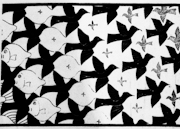 |
Early in 2010 Lynne agreed to be one of the
local artists painting or decorating one of
forty life-size models of a donkey for charity.
These were to celebrate the opening of the new
Grand Pier and were to be auctioned in November
to raise money for the RNLI and Children in
Need. (Due to the delayed opening of the Pier,
the auction will now be held sometime in 2011.)
Lynne decided to decorate the white-primed fibre
glass donkey with a design inspired by the
‘Metamorphosis’ work of Dutch artist M. C.
Escher, who was a master of optical illusions
and impossible perspective.
Escher’s work, shown here, involves a grid
system of objects which gradually change shape,
with the spaces between them forming different
objects --- so that moths “morph” into birds,
while the background shapes between them form
fish. Studying his work and discovering the
complex difficulties in doing a similar design
has left Lynne with a very healthy respect for
his genius.
|
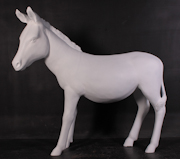 |
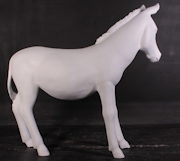 |
Lynne experimented with various objects
associated with Weston, but it had to be those
which formed other shapes between them, and fish
and birds were the only suitable shapes which
would interlock in this way.
She used a fish shape to accentuate each eye of
the donkey and pointed shapes to fill any
spaces, forming stripes on the legs and
waves/cloud shapes on the sides.
The background was painted first in deep violet,
then each shape was given a base colour of
orange, blue or lilac. Finally all the shapes,
hooves, mane etc were painted with pearlescent
or metallic top colours.
The shoals of orange/gold fish down the left
side (with background bird shapes between)
change to the background violet across the chest
so that, on the right side, the violet bird
shapes become flocks of blue birds (with fish
shapes between), ie, the chest gives the key to
the puzzle.
This “hard edge” design was particularly
difficult and took so long to paint because the
edge of each bird is also the edge of a fish, so
every shape had to be painted precisely up to
(not over) the line, otherwise the other shape
would be distorted.
On top of this, because acrylic paint is rather
transparent, each colour needed four to six
coats, finished with five coats of varnish
overall.
Her design time was not recorded, but Lynne
spent over 200 hours painting the donkey, mostly
evenings, spread over four months. This included
renovation work on the eyes which were both
damaged, but are now as good as new.
|
|
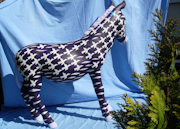 |
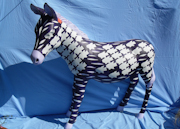 |
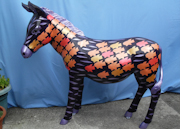 |
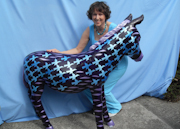 |
|
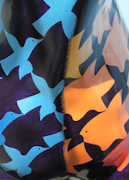 |
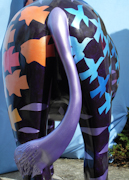 |
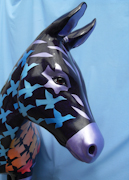 |
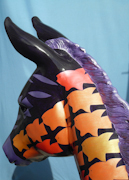 |
Lynne’s donkey was sponsored by Weston Mercury
and is on display in their Boulevard office. |
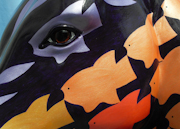 |
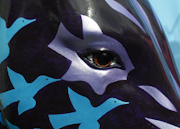 |
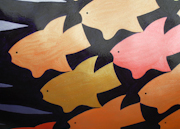 |
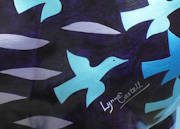 |
|
|
|
|